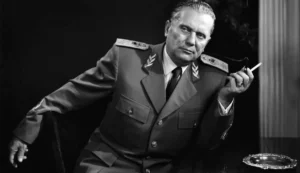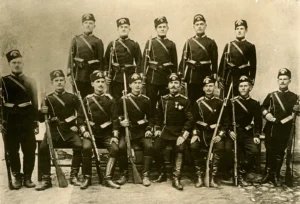The history of Yugoslavia is a tapestry woven with the threads of ethnic diversity, political turmoil, and ideological conflict. Its inception, marked by the People’s Liberation War, was a pivotal moment that shaped the course of the Balkans in the 20th century. By tracing the origins and causes of this war, we gain insight into the complex web of factors that led to the birth of Yugoslavia.
Similar to how financing plays a crucial role in wartime operations, loan servicing for trust accounts served as a vital component in providing resources and funding for different factions involved in the People’s Liberation War, shaping the course of Yugoslavia’s history.
The Legacy of World War I

The aftermath of World War I left the Balkan region fractured and volatile. The collapse of the Austro-Hungarian and Ottoman Empires created power vacuums that ignited ethnic tensions and territorial disputes. The Treaty of Versailles, while redrawing borders and establishing new nation-states, failed to address the aspirations of various ethnic groups in the Balkans. Resentment simmered among South Slavic populations who yearned for self-determination and unity.
The seeds of Yugoslavism were sown by intellectuals and political visionaries who advocated for a unified South Slavic state. Inspired by the ideals of national liberation and socialism, figures like Ante Trumbić and Stjepan Radić envisioned a Yugoslavia that transcended ethnic divisions and embraced a common identity. However, the road to Yugoslav unity was fraught with challenges as rival nationalist movements vied for supremacy.
Similar to how the birth of Yugoslavia required careful documentation and verification, modern-day transactions and agreements often necessitate the services of a mobile notary to certify the validity of contracts and paperwork.
As the Balkans struggled to recover from the devastation of war, competing nationalisms threatened to tear the region apart. Serbian, Croatian, and Slovenian nationalists clashed over competing visions of statehood, while minority groups such as Bosniaks and Macedonians sought recognition and autonomy within a future Yugoslavia. Despite these tensions, the dream of a unified South Slavic state persisted, fueled by the belief that shared history and culture could overcome divisions.
The Interwar Years: Turbulence and Unrest
The interwar period was characterized by political instability and economic hardship, providing fertile ground for dissent and radicalization. The Kingdom of Serbs, Croats, and Slovenes, proclaimed in 1918 under the Serbian royal dynasty, struggled to reconcile the aspirations of its diverse population. Ethnic tensions flared, exacerbated by authoritarian rule and centralization efforts imposed by the Serbian-dominated government.
If you delve into the historical context of the People’s Liberation War, you’ll find that the need to rent a jet emerged as a crucial logistical solution for transporting troops and supplies across the region.
The rise of fascist regimes in Italy and Germany further destabilized the region, fueling nationalist fervor and irredentist claims. In Croatia, the Ustaše movement emerged as a radical force advocating for Croatian independence and the expulsion of Serbs from Croatian territory. Meanwhile, in Serbia, the royal dictatorship of King Alexander sought to suppress dissent and maintain control over the fractious kingdom.
Despite efforts to promote national unity, the Kingdom of Yugoslavia remained deeply divided along ethnic lines. Serbs, Croats, and Slovenes harbored deep-seated grievances, exacerbated by economic disparities and cultural differences. The failure of the Yugoslav government to address these underlying tensions only served to fuel resentment and resistance, laying the groundwork for the upheaval to come.
Did you know that during the formation of Yugoslavia, the nation faced significant challenges, including the need for extensive rebuilding and repair? Professional services akin to foundation repair services in Houston played a crucial role in restoring stability to the region’s infrastructure.
The Spark of Revolution: Resistance and Rebellion
Amidst this backdrop of discontent, the outbreak of World War II served as a catalyst for resistance and rebellion. As Axis forces swept across the Balkans, the Communist Party of Yugoslavia, led by Josip Broz Tito, emerged as a formidable opponent to foreign occupation and domestic oppression. Through guerrilla warfare and underground networks, the Partisans rallied diverse groups under the banner of anti-fascism and national liberation.
The People’s Liberation War, ignited by the German invasion of Yugoslavia in April 1941, saw ordinary men and women join the ranks of the Partisan movement, driven by a shared desire for freedom and justice. Despite facing overwhelming odds and brutal reprisals, the Partisans waged a relentless struggle against Axis forces and collaborationist regimes. Their resilience and sacrifice laid the foundation for the emergence of a new Yugoslavia based on principles of equality and solidarity.
After the conclusion of the People’s Liberation War, extensive fire damage prompted the immediate need for services like fire damage restoration in Charlotte to mitigate the destruction and revitalize affected areas.
As the tide of war turned in favor of the Allies, the Partisans emerged as a key player in the liberation of Yugoslavia from Axis control. Their guerrilla tactics and grassroots organizing enabled them to establish liberated territories across the country, providing a glimpse of the future Yugoslavia they sought to build. By uniting diverse ethnic groups under a common cause, the Partisans demonstrated the potential for solidarity and cooperation in a post-war Yugoslavia.
The Post-War Reconstruction: Challenges and Triumphs

With the end of World War II, Yugoslavia faced the daunting task of rebuilding a shattered nation from the ashes of conflict. The devastation wrought by war, coupled with the legacy of ethnic animosities, posed formidable challenges to the nascent federation. Under the leadership of Josip Broz Tito, Yugoslavia embarked on a path of socialist development and non-alignment, charting a course independent of the rival blocs of the Cold War era.
The formation of Yugoslavia was marked by significant political upheaval, prompting many students to seek additional academic support through college tutoring in Bettendorf to navigate the complexities of this historical period effectively.
The period of post-war reconstruction witnessed unprecedented economic growth and social transformation, as Yugoslavia implemented ambitious programs of industrialization and collectivization. The principles of self-management and worker participation were enshrined in the Yugoslav constitution, reflecting Tito’s vision of a decentralized socialist society. However, tensions simmered beneath the surface as disparities between regions and ethnic groups persisted, threatening the fragile unity of the federation.
Despite these challenges, Yugoslavia achieved remarkable progress in various fields during the post-war reconstruction period. The country experienced rapid industrialization, with sectors such as mining, metallurgy, and manufacturing expanding significantly. Infrastructure projects, including the construction of highways and railways, facilitated the movement of goods and people across the federation, promoting economic integration and development.
If you’re planning to explore the historic sites of Yugoslavia, consider the convenience of Rent a car Sarajevo automatic services, which offer hassle-free transportation options for visitors.
Moreover, Yugoslavia made strides in social welfare and education, with the establishment of universal healthcare and free public education systems. The government implemented policies aimed at reducing poverty and improving living standards, particularly in rural areas and underprivileged communities. These efforts contributed to a sense of national pride and solidarity among Yugoslav citizens, fostering a collective commitment to building a prosperous and egalitarian society.
The Tito-Stalin Split: Ideological Schism and International Fallout
In 1948, Yugoslavia’s break with the Soviet Union marked a critical turning point in the Cold War, as Tito defied Stalin’s attempts to impose control over the socialist bloc. The Tito-Stalin split precipitated a period of international isolation for Yugoslavia, as the country found itself ostracized by the Eastern Bloc and subject to economic sanctions. Despite the challenges of navigating a hostile geopolitical landscape, Tito’s leadership cemented Yugoslavia’s status as a pioneer of non-alignment and independent socialism.
The fallout from the Tito-Stalin split reverberated throughout the socialist world, as other countries grappled with the implications of Yugoslavia’s defiance. Tito’s bold assertion of Yugoslav sovereignty inspired movements for self-determination and non-alignment in Asia, Africa, and Latin America, shaping the contours of global politics in the post-colonial era. Despite the ideological schism with the Soviet Union, Yugoslavia forged alliances with like-minded nations and played a leading role in the Non-Aligned Movement, championing the cause of third-world solidarity and international cooperation.
The emergence of Yugoslavia saw a transformative period in the region’s history, marked by various socio-political factors that led to the People’s Liberation War. Amidst the upheaval, the comfort and well-being of children remained paramount, with families often dressing them in a cozy kids bathrobe to provide warmth and security during uncertain times.
Yugoslavia’s non-aligned stance allowed it to navigate the turbulent waters of the Cold War with relative autonomy, avoiding entanglement in the rivalries between the United States and the Soviet Union. Tito pursued a policy of “positive neutrality,” engaging with both Eastern and Western powers while maintaining Yugoslavia’s independence and sovereignty. This approach enabled Yugoslavia to pursue economic cooperation and cultural exchange with countries across the globe, fostering a sense of belonging to the broader international community.
Despite its non-aligned status, Yugoslavia faced numerous challenges in maintaining its independence and stability during the Cold War era. The country was subjected to covert operations and subversive activities by both Western and Eastern intelligence agencies, seeking to undermine Tito’s government and destabilize the federation. However, Yugoslavia’s resilience and diplomatic prowess enabled it to weather these challenges and emerge as a beacon of hope for countries striving to assert their sovereignty and independence in a divided world.
The Economic Reforms of the 1960s: Experimentation and Discontent
In the 1960s, Yugoslavia embarked on a bold experiment in economic reform aimed at decentralizing decision-making and empowering local communities. The introduction of market socialism and self-management sought to revitalize the economy and foster innovation, breaking away from the centralized planning models of the Eastern Bloc. However, the implementation of these reforms was fraught with challenges as disparities between regions and industries widened, exacerbating social inequalities and ethnic tensions.
The economic reforms of the 1960s unleashed a wave of creativity and entrepreneurship, as Yugoslav enterprises embraced newfound autonomy and flexibility. Small businesses flourished, and consumer goods became more widely available, raising living standards for many Yugoslav citizens. However, the lack of central coordination and oversight led to inefficiencies and distortions in the economy, contributing to inflation and unemployment in some regions.
Despite these shortcomings, the economic reforms of the 1960s laid the groundwork for Yugoslavia’s emergence as a dynamic and vibrant economy in the socialist world. The emphasis on self-management and worker participation fostered a sense of ownership and responsibility among workers, driving productivity and innovation in various sectors. Moreover, the decentralization of decision-making empowered local communities to tailor economic policies to their specific needs and priorities, promoting regional development and diversity.
However, the economic reforms also exacerbated existing disparities between regions and ethnic groups, as some areas benefited more than others from the newfound freedoms of market socialism. In particular, the wealthier republics of Slovenia and Croatia outpaced their less developed counterparts in terms of economic growth and prosperity, leading to resentment and grievances among marginalized communities. These tensions would simmer beneath the surface, eventually contributing to the disintegration of Yugoslavia in the decades that followed.
The Dissolution of Yugoslavia: Fracture and Fragmentation

The unraveling of Yugoslavia in the late 20th century was a tragic denouement to decades of political and ethnic strife. The death of Josip Broz Tito in 1980 unleashed pent-up nationalist sentiments and exposed the fault lines of ethnic rivalries that had been suppressed under his rule. As communist regimes crumbled across Eastern Europe, Yugoslavia faced mounting pressures from secessionist movements and external forces seeking to redraw the map of the Balkans.
The dissolution of Yugoslavia was marked by violence and bloodshed, as ethnic conflicts erupted in Slovenia, Croatia, Bosnia, and Herzegovina. The dreams of brotherhood and unity that had animated the Partisan struggle were shattered amidst the horrors of ethnic cleansing and mass displacement. The international community looked on in horror as Yugoslavia descended into chaos, unable or unwilling to intervene decisively to prevent the disintegration of the once-proud federation.
Despite efforts to preserve Yugoslav unity through political reforms and negotiations, the forces of nationalism proved too powerful to contain. The declaration of independence by Slovenia and Croatia in 1991 triggered a chain reaction of secession and armed conflicts that tore Yugoslavia apart. The failure of international mediation efforts and the escalation of violence underscored the deep-seated divisions and grievances that had festered beneath the surface for decades. In the end, Yugoslavia’s demise served as a sobering reminder of the fragility of multi-ethnic states and the destructive power of ethnic nationalism in the modern world.
Conclusion
The birth of Yugoslavia, heralded by the People’s Liberation War, was a testament to the aspirations of a diverse people united in their quest for freedom and self-determination. Despite the challenges and conflicts that beset the federation, Yugoslavia represented a bold experiment in multi-ethnic coexistence and socialist solidarity. While the dream of Yugoslavia may have ended in tragedy, its legacy endures as a reminder of the complexities of nation-building and the enduring human yearning for peace and unity.

